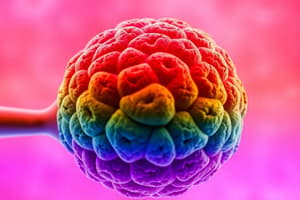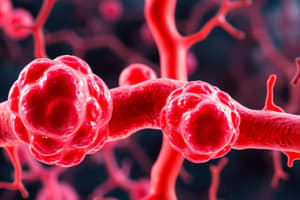Podcast
Questions and Answers
What defines carcinogenesis?
What defines carcinogenesis?
- A method for treating existing tumors
- A process that always leads to benign tumors
- The process through which cancer develops (correct)
- The generation of energy in cancer cells
Which of the following statements is true about benign neoplasms?
Which of the following statements is true about benign neoplasms?
- They are always malignant
- They exhibit rapid invasive growth
- They do not invade surrounding tissues (correct)
- They can metastasize to other tissues
What characterizes malignant neoplasms?
What characterizes malignant neoplasms?
- They are always non-invasive
- They grow slowly and invade surrounding tissues
- They are synonymous with benign tumors
- They can metastasize to distant sites (correct)
What are carcinogens?
What are carcinogens?
Which type of carcinogen interacts with DNA and results in mutation?
Which type of carcinogen interacts with DNA and results in mutation?
What is a key difference between benign and malignant tumors?
What is a key difference between benign and malignant tumors?
Which of the following best describes metastases?
Which of the following best describes metastases?
Which characteristic is NOT associated with cancer?
Which characteristic is NOT associated with cancer?
What type of tumor is defined as a neoplasm that can grow autonomously?
What type of tumor is defined as a neoplasm that can grow autonomously?
What distinguishes nongenotoxic carcinogens from genotoxic carcinogens?
What distinguishes nongenotoxic carcinogens from genotoxic carcinogens?
What characterizes direct-acting carcinogens?
What characterizes direct-acting carcinogens?
Which of the following is an example of an indirect-acting carcinogen?
Which of the following is an example of an indirect-acting carcinogen?
Which category do hormones such as estrogens fall under concerning carcinogenesis?
Which category do hormones such as estrogens fall under concerning carcinogenesis?
What is the role of a co-carcinogen in carcinogenesis?
What is the role of a co-carcinogen in carcinogenesis?
Which of the following substances is categorized as a solid state agent?
Which of the following substances is categorized as a solid state agent?
What is a procarcinogen?
What is a procarcinogen?
Which mechanism may a co-carcinogen use to enhance tumor formation?
Which mechanism may a co-carcinogen use to enhance tumor formation?
Which of the following is an example of an immunosuppressive xenobiotic?
Which of the following is an example of an immunosuppressive xenobiotic?
What is the ultimate carcinogen?
What is the ultimate carcinogen?
What effect does uranium dust exposure have in smokers?
What effect does uranium dust exposure have in smokers?
What is necessary for the initiation stage of carcinogenesis?
What is necessary for the initiation stage of carcinogenesis?
Which of the following describes the promotion stage of carcinogenesis?
Which of the following describes the promotion stage of carcinogenesis?
What suffix indicates a malignant tumor originating from epithelial cells?
What suffix indicates a malignant tumor originating from epithelial cells?
What type of agents are usually involved in the promotion phase of carcinogenesis?
What type of agents are usually involved in the promotion phase of carcinogenesis?
Which of the following is a type of cancer that originates from muscle tissue?
Which of the following is a type of cancer that originates from muscle tissue?
Which characteristic is true of the progression stage of carcinogenesis?
Which characteristic is true of the progression stage of carcinogenesis?
What is the nature of DNA modification during the initiation stage?
What is the nature of DNA modification during the initiation stage?
Which of these substances is classified as a DNA-damaging agent?
Which of these substances is classified as a DNA-damaging agent?
What is the suffix for benign tumors originating from the liver?
What is the suffix for benign tumors originating from the liver?
In carcinogenesis, which of the following agents is NOT typically a promoter?
In carcinogenesis, which of the following agents is NOT typically a promoter?
Which type of cancer arises from neural stem cells?
Which type of cancer arises from neural stem cells?
Which statement about initiating agents is correct?
Which statement about initiating agents is correct?
What is a characteristic of the promotion phase in relation to exposure?
What is a characteristic of the promotion phase in relation to exposure?
Which category of carcinogens does not damage DNA directly?
Which category of carcinogens does not damage DNA directly?
Hepatitis B and C viruses are categorized as which type of carcinogen?
Hepatitis B and C viruses are categorized as which type of carcinogen?
How is the DNA modification during the progression phase described?
How is the DNA modification during the progression phase described?
Which of the following best describes the role of promoters in carcinogenesis?
Which of the following best describes the role of promoters in carcinogenesis?
Which tumor is characterized by malignant transformation of melanocytes?
Which tumor is characterized by malignant transformation of melanocytes?
Which term describes a benign tumor arising from bone tissue?
Which term describes a benign tumor arising from bone tissue?
What type of neoplasm is characterized as a blood-forming cell cancer?
What type of neoplasm is characterized as a blood-forming cell cancer?
Flashcards
Cancer Incidence and Age
Cancer Incidence and Age
Most cancers become more common as people age.
Benign vs. Malignant Tumors
Benign vs. Malignant Tumors
Benign tumors are non-cancerous and often slow-growing. Malignant tumors are cancerous and invasive.
Tumor Suffix
Tumor Suffix
A suffix added to the tissue type to indicate a tumor. For example, 'oma' for a tumor of the epithelial cells.
Carcinoma
Carcinoma
Signup and view all the flashcards
Sarcoma
Sarcoma
Signup and view all the flashcards
Melanoma
Melanoma
Signup and view all the flashcards
Leukemia
Leukemia
Signup and view all the flashcards
Lymphomas
Lymphomas
Signup and view all the flashcards
Types of Carcinogens
Types of Carcinogens
Signup and view all the flashcards
Genotoxic Carcinogens
Genotoxic Carcinogens
Signup and view all the flashcards
Carcinogenesis
Carcinogenesis
Signup and view all the flashcards
Chemical Carcinogenesis
Chemical Carcinogenesis
Signup and view all the flashcards
Neoplasm or Tumor
Neoplasm or Tumor
Signup and view all the flashcards
Benign Neoplasm
Benign Neoplasm
Signup and view all the flashcards
Malignant Neoplasm
Malignant Neoplasm
Signup and view all the flashcards
Metastases
Metastases
Signup and view all the flashcards
Cancer
Cancer
Signup and view all the flashcards
Nongenotoxic Carcinogen
Nongenotoxic Carcinogen
Signup and view all the flashcards
Initiation
Initiation
Signup and view all the flashcards
Promotion
Promotion
Signup and view all the flashcards
Progression
Progression
Signup and view all the flashcards
Initiating Agent
Initiating Agent
Signup and view all the flashcards
Promoter
Promoter
Signup and view all the flashcards
Electrophiles
Electrophiles
Signup and view all the flashcards
Preneoplastic Lesion
Preneoplastic Lesion
Signup and view all the flashcards
Neoplastic Lesion
Neoplastic Lesion
Signup and view all the flashcards
Conversion of Preneoplastic Lesions
Conversion of Preneoplastic Lesions
Signup and view all the flashcards
Single Exposure to Initiating Agent
Single Exposure to Initiating Agent
Signup and view all the flashcards
Direct-acting carcinogens
Direct-acting carcinogens
Signup and view all the flashcards
Indirect-acting carcinogens
Indirect-acting carcinogens
Signup and view all the flashcards
Procarcinogen
Procarcinogen
Signup and view all the flashcards
Proximate carcinogen
Proximate carcinogen
Signup and view all the flashcards
Ultimate carcinogen
Ultimate carcinogen
Signup and view all the flashcards
Epigenetic agents
Epigenetic agents
Signup and view all the flashcards
Co-carcinogens
Co-carcinogens
Signup and view all the flashcards
Co-carcinogen: Increased Initiator
Co-carcinogen: Increased Initiator
Signup and view all the flashcards
Co-carcinogen: Inhibition of DNA Repair
Co-carcinogen: Inhibition of DNA Repair
Signup and view all the flashcards
Co-carcinogen: Increased Metabolite Concentration
Co-carcinogen: Increased Metabolite Concentration
Signup and view all the flashcards
Study Notes
Carcinogenesis
- Carcinogenesis is the process through which cancer develops
- Chemical carcinogenesis is the study of mechanisms through which chemical carcinogens induce cancer, and conducting experiments to identify potential human carcinogens
Tumor
- Tumor is a tissue swelling. The term is now used as a synonym for neoplasm
- Neoplasm (or tumor) is the growth of abnormal tissue, which is uncoordinated with normal tissue and persists after the stimulus that created it stops.
- There are two types of neoplasms:
- Benign: characterized by slow growth, doesn't invade surrounding tissues, no metastases
- Malignant: characterized by relatively fast growth, invades surrounding tissues, and has metastases
- Cancer is a type of neoplasm, used as the general name for a malignant neoplasm
Carcinogen
- A carcinogen is a physical or chemical agent that causes or induces a neoplasm
- Carcinogens are categorized into two classes:
- Genotoxic: interact with DNA, resulting in mutations
- Nongenotoxic: modify gene expression, but do not damage DNA
Cancer
- Cancer is one of the leading causes of death worldwide
- Cancer is characterized by:
- Uncontrolled growth of abnormal cells
- Tissue invasion and metastasis
- Mutation and proliferation
- Incidence of most cancers increases with age
Terminology of Cancer
-
Suffixes for tissue of origin are used to classify cancer types
- Epithelial cells: adenoma (benign), carcinoma (malignant)
- Mesenchymal cells: -oma (benign), sarcoma (malignant)
- Melanocytes: melanoma (malignant)
-
Blood-forming cells: leukemia, lymphomas
Causes of Cancer
- 70-90% of cancers are linked to environmental, dietary, and behavioral factors, including chemicals, radiation, and infectious agents
- Factors contributing to cancer incidence:
- Diet: 35%
- Tobacco: 30%
- Infection: 10%
- Sexual behavior :7%
- Occupational exposure: 4%
- Alcohol: 3%
- UV/Radiation: 3%
- Pollution: 2%
Types of Carcinogens
- Chemicals: benzene, asbestos, cigarette smoke, arsenic compounds
- Viruses: Hepatitis B & C, HIV type 1
- Radiation: UV and X-ray radiation, Radioactive isotopes
Classes of Carcinogens
-
Carcinogens are classified based on their mutagencitiy:
- DNA-damaging agents (genotoxic): Carcinogens producing permanent DNA alterations, leading to mutations.
- Direct-acting: bind directly to DNA without metabolic activation (e.g., mustard gases, arsenic, benzene)
- Indirect-acting: require metabolic activation to be carcinogenic (e.g., many chemical compounds, including certain combustion products)
- Epigenetic agents (nongenotoxic): Do not damage DNA; affect gene expression (e.g., hormones, some industrial chemicals, and some environmental pollutants). Affect processes like proliferation, differentiation, and apoptosis
- DNA-damaging agents (genotoxic): Carcinogens producing permanent DNA alterations, leading to mutations.
Co-carcinogenesis
- A co-carcinogen enhances the effects of genotoxic carcinogens, significantly increasing tumor development.
- Mechanisms:
- Increased concentration of initiator/genotoxic carcinogen
- Inhibition of DNA repair
- Enhancement of reactive metabolite conversion
Stages of Carcinogenesis
- Initiation: irreversible DNA damage occurs
- Promotion: clonal expansion of initiated cells, leading to preneoplastic lesions
- Progression: preneoplastic lesions evolve into malignant tumors
Characteristics of the Stages of Carcinogenesis
-
Initiation: DNA damage, modification, and mutation. Requires cell division, is irreversible, and initiated cells can remain dormant. Electrophiles are initiating agents.
-
Promotion: Clonal expansion of initiated cells to produce pre-neoplastic lesions, reversible, and cells do not need to have DNA modification. Require prolonged exposure to promoters rather than a single exposure needed for initiating agents.
-
Progression: conversion of preneoplastic lesions into malignant tumors, it is irreversible, and causes additional genetic events.
Studying That Suits You
Use AI to generate personalized quizzes and flashcards to suit your learning preferences.





